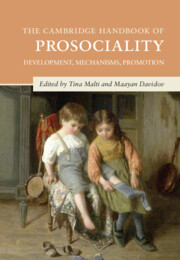Book contents
- The Cambridge Handbook of Prosociality
- Cambridge Handbooks in Psychology
- The Cambridge Handbook of Prosociality
- Copyright page
- Dedication
- Contents
- Figures
- Contributors
- Part I Development of Prosociality
- Part II Antecedents and Mechanisms of Prosociality
- Part III Development of Prosociality in Context
- 18 Parenting and Children’s Prosociality
- 19 Sibling Influences on Prosociality
- 20 Prosocial Behavior, Peer Relationships, and Friendships
- 21 Children’s Intergroup Prosocial Behavior
- 22 Prosocial Behavior in School Contexts
- 23 Community and Neighborhood Influences on Prosociality in Children and Youth
- 24 Culture and Prosociality
- 25 Prosocial Media
- Part IV Applications
- Index
- References
24 - Culture and Prosociality
from Part III - Development of Prosociality in Context
Published online by Cambridge University Press: 25 May 2023
- The Cambridge Handbook of Prosociality
- Cambridge Handbooks in Psychology
- The Cambridge Handbook of Prosociality
- Copyright page
- Dedication
- Contents
- Figures
- Contributors
- Part I Development of Prosociality
- Part II Antecedents and Mechanisms of Prosociality
- Part III Development of Prosociality in Context
- 18 Parenting and Children’s Prosociality
- 19 Sibling Influences on Prosociality
- 20 Prosocial Behavior, Peer Relationships, and Friendships
- 21 Children’s Intergroup Prosocial Behavior
- 22 Prosocial Behavior in School Contexts
- 23 Community and Neighborhood Influences on Prosociality in Children and Youth
- 24 Culture and Prosociality
- 25 Prosocial Media
- Part IV Applications
- Index
- References
Summary
This chapter provides an overview of the similarities and differences in the development of prosociality across cultural contexts and examines the role of social cognitive and motivational factors in shaping cultural diversity. We focus on helping and sharing, examined most extensively across cultures. Low-cost helping and sharing show similar developmental trajectories and levels across cultures. Development of costly helping diverges across cultures in the second year. Costly sharing diverges around middle childhood, coinciding with children’s adherence to cooperative norms of their society. Social cognitive foundations of prosociality develop along similar trajectories, suggesting that diversity in costly prosocial behaviors is best explained by motivational processes. New research suggests that collaboration influences motivational processes, producing similar levels of costly prosociality across diverse societies. To identify the psychological and sociocultural mechanisms underlying human development, it is critical to merge deep understanding of the everyday lives of children with theoretically guided experiments.
- Type
- Chapter
- Information
- The Cambridge Handbook of ProsocialityDevelopment, Mechanisms, Promotion, pp. 477 - 500Publisher: Cambridge University PressPrint publication year: 2023
References
- 1
- Cited by



